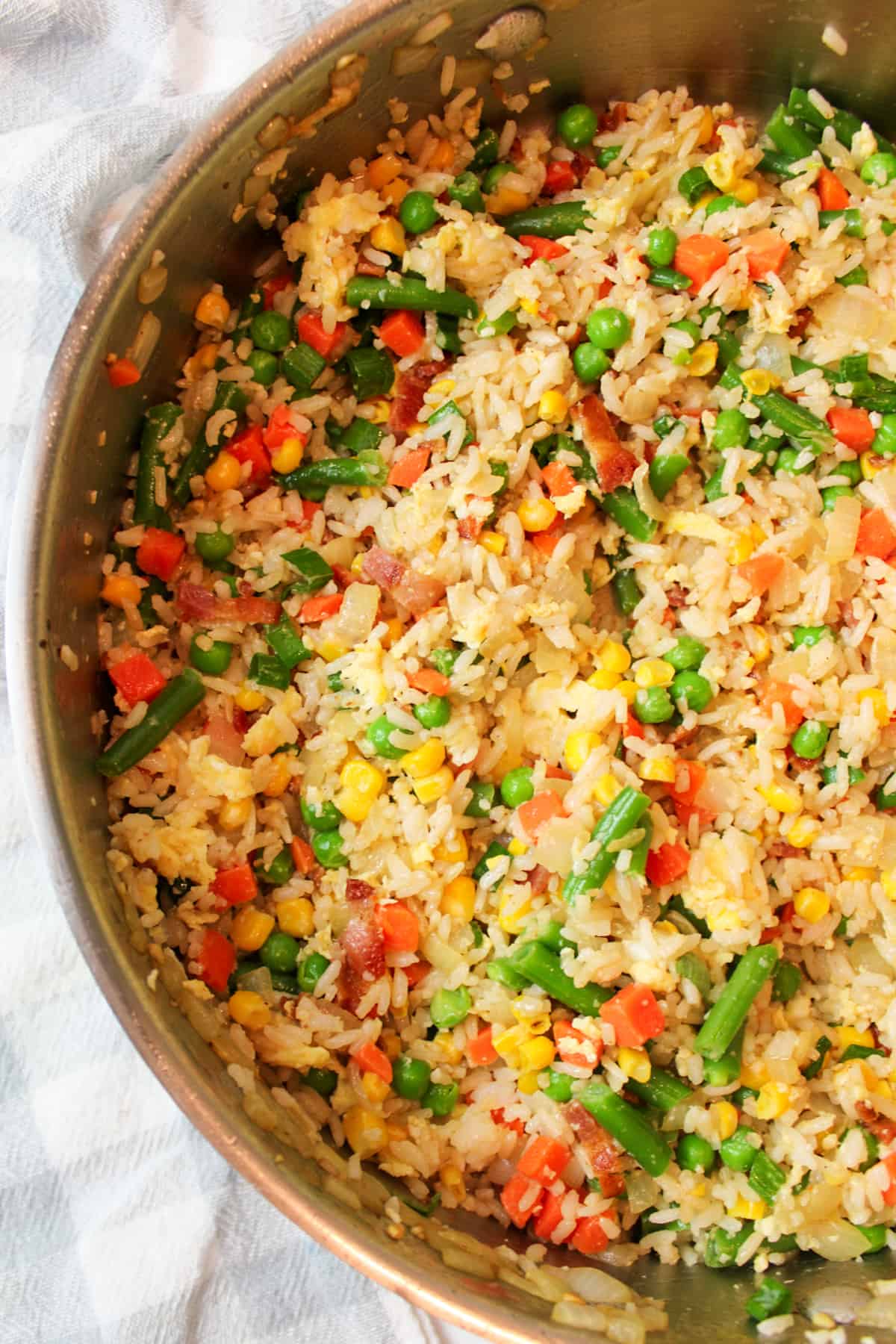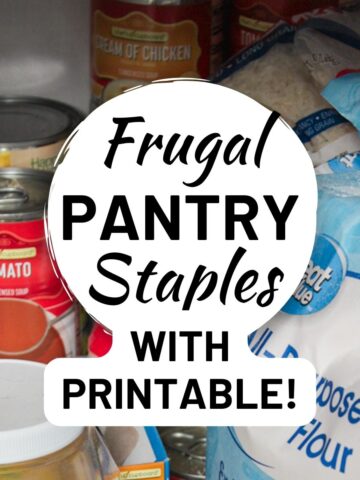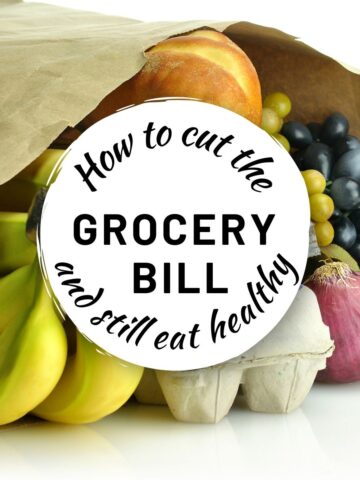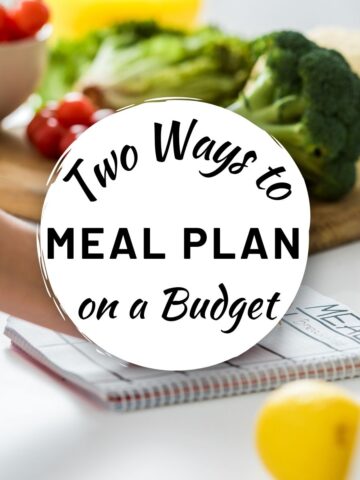If the following sounds like you, a pantry challenge might be in order.
You currently have more food in the house than you’re eating.
It’s common to plan a meal, buy ingredients and then change the plan before ever using the ingredients.
Now you have cans of Manwich and a random jar of pearl onions (or similar random odds and ends) in your pantry collecting dust. Do you even remember buying that can of creamed corn?
You remind yourself to use them every time they catch your eye but forget about them just as soon as the pantry door closes.
What is a Pantry Challenge?
A pantry challenge (also known as a no grocery challenge) is similar to a no-spend challenge. The ultimate goal of a pantry challenge is to reduce spending on food, in an attempt to save money. This happens while you're using up odds and ends to prevent food waste.

You set a goal to not buy groceries for a period of time (often 1 month). Instead of shopping for meals at the store, you're shopping in your pantry.
Of course, it wouldn’t be a civilized challenge without rules in place. During a challenge, it’s recommended to leave an amount of money to shop with weekly to keep fresh milk, eggs, and produce in the home as those are important dietary staples or basic pantry staples.
A grocery challenge is great to cut costs, save money, reduce your grocery bill and just have fun. A creative challenge that puts money back into your wallet, er, rather, doesn't take money out of the wallet in the first place.
Jump to:
Pantry Challenge Tips
Cooking from your pantry can be much easier than you may think. There are very few foods that can’t be turned into a soup or a casserole dish of some sort. Creatively piecing together meals is key to having a successful pantry challenge.
We've turned Thanksgiving leftovers into soups with our Creamy Leftover Turkey Wild Rice Soup and Creamy Turkey Dumpling Soup, but we've also made casseroles with leftovers like our Southern Baked Spaghetti.
As the month wears on you may start to fear that you are using essential items and will need to restock. Where are the savings if you have to rebuy items all over again next month?
- Kitchen seasonings should be replaced once a year or so if you didn't replace them throughout the year. This is because once opened, they start to lose potency.
- Things like flour, oats, and rice can get little bugs when they sit for too long and should be rotated more often.
- Other food goes rancid, expires, loses the quality and really old dry beans are dang near impossible to cook to an edible texture.
Using items is really doing yourself a favor.
You basically give yourself a clean slate to work with, which is great. Yes, it may cost a little money to replace some ingredients in your home, but if you do the challenge correctly, you can use the grocery savings to replace the items and still have money in your pocket.
The cost of replacing a bag of flour, a jar of spice, and some rice is still far less than you would have originally spent on groceries for the month.

Eating at Home is Cheaper
I had a conversation with a 54-year-old woman who was a stay-at-home wife, that refused to cook. Not because she didn’t know how, but because she didn’t want to. So they were spending over $1,000 a month eating out and having fast food delivered. All I could think was “ouch.” 2 people spending that much money a month, and never eating a home-cooked meal.
While there's nothing wrong with staying home or not cooking, there are far cheaper ways to feed 2 people per month and the savings could be multiplied if her or her husband would prep some meals at home.
You can save a lot of money by cooking your food from scratch. Even so, if you compared store-bought ready-made items to the cost of a sit-down dinner, you’d still look at savings and minimal effort.
An Easy Way To Think of Meals
Here are 3 great websites you can use to put meals together using the random food items in your home. You can find some great dishes you didn’t even know were possible!
Preparing for The Challenge
Before you jump straight into a pantry challenge, there are some things you should do to prepare yourself mentally and physically.
Write out a list of goals.
- Why are you doing this, and what do you hope to get out of it?
- Are you saving money for something specific, or are you just trying to use up as much food in the house as you can?
I often do a little challenge towards the end of the month where I use up the sadly forgotten celery of eye sprouting potatoes and create meals using what we have on hand so that the next month can start fresh.
Purchase the basic grocery items to help you get started.
If you don’t already have milk, flour, eggs, and fresh produce, you should buy them now before starting the challenge so you can reduce trips to the store later.

Set a Grocery Budget
For example- if you normally spend $600 a month on groceries, bring it down to half. Pull the money out in cash, and leave your debit card in an underwear drawer or freezer (somewhere out of the site and out of mind for the month).
If there are 4 weeks this month, take that $300 and divide it up into 4 envelopes. One for each week, and if you use a white mailing envelope, you can also write on it to label it with the date and your shopping list for extra efficiency.
Spending less is always a plus in this challenge, but don’t feel that you need to do it at the risk of your family's health.
If you want to save more money, you can opt for canned or frozen fruits and veggies whenever possible, but make sure that children are meeting the nutrition requirements. Choosing to skip a meal is your choice, but always make sure that kids have plenty of food options during the day so they can stay healthy.
If you want to make some frugal foods fun, Pinterest has a wealth of great ideas!
A slice of toast, with peanut butter, two chocolate chips, a raisin, and 3 sliced coins of banana makes a really cute teddy bear toast for breakfast. Even a sliced apple can be made more fun by turning them into No Bake Apple Donuts.
Proof that even the cheapest of meals can be made more fun.
[Related] Check out Tips for Meal Planning on a Tight Budget
Take Action
- Make realistic goals
- Make meal plans based on what you already have in the house
- Set up a small weekly grocery budget for necessities
- Stick to the budget and get creative with your meal planning to use up odds and ends
- Enjoy the money you've saved and the goals you've reached
More helpful money-saving posts to check out soon!





Comments
No Comments